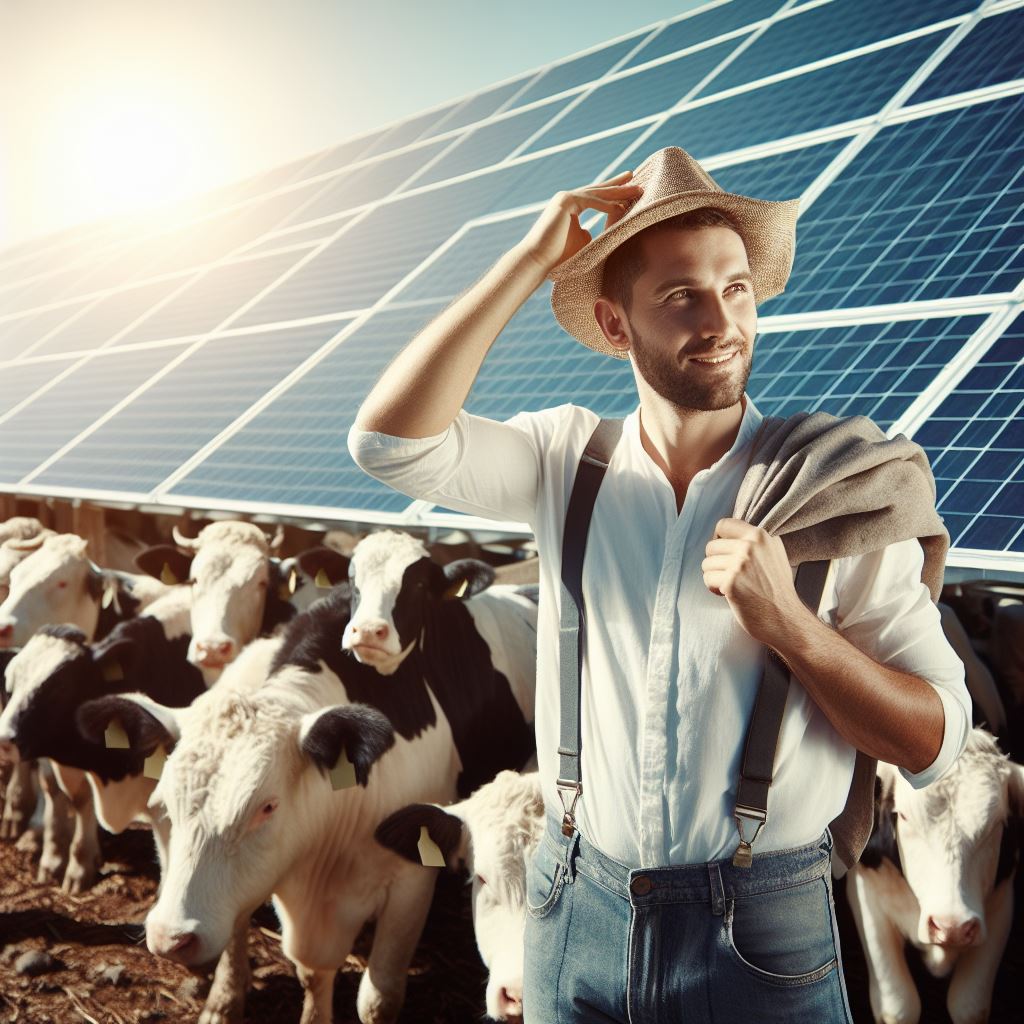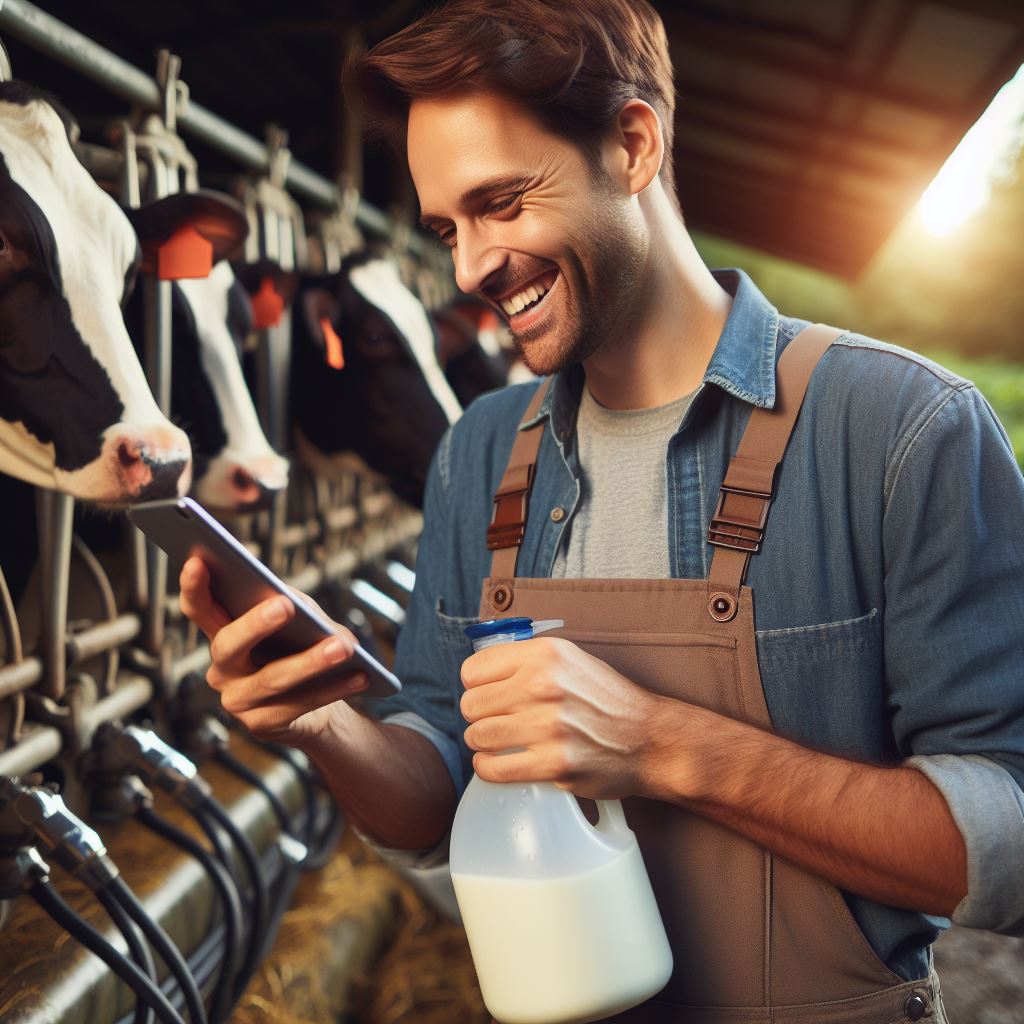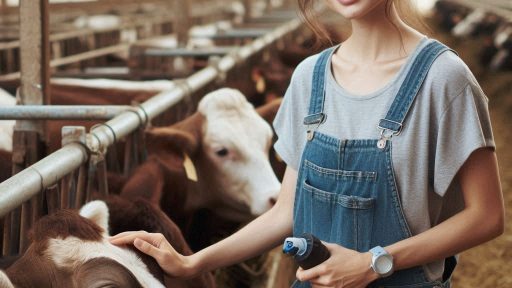Introduction
Overview of the topic
Solar power in livestock farming refers to harnessing the sun’s energy to meet the energy needs of farming operations.
The integration of solar power in livestock farming is a sustainable approach revolutionizing the agricultural sector.
This guide explores the benefits and practicalities of implementing solar solutions on farms, emphasizing reduced energy costs, environmental impact mitigation, and increased self-sufficiency.
It covers the selection of appropriate solar technologies, their installation, and maintenance in the context of livestock operations.
By harnessing solar energy, farmers can enhance efficiency, cut operational expenses, and contribute to a greener future.
The guide serves as a comprehensive resource for farmers looking to optimize energy usage and embrace eco-friendly practices in the dynamic landscape of livestock farming.
Brief explanation of the importance of solar power in livestock farming
Solar power offers numerous benefits for livestock farming, including cost savings, sustainability, and energy independence.
Solar power plays a crucial role in modernizing and sustainable livestock farming. It offers a reliable and clean energy source, reducing dependence on traditional grid power and minimizing carbon footprint.
Solar panels can power essential farm operations, such as water pumping, lighting, and ventilation systems, ensuring a stable environment for livestock.
This not only enhances operational efficiency but also reduces long-term energy costs. Additionally, solar power helps farmers become more resilient to power outages and volatile energy prices.
Embracing solar technology in livestock farming aligns with environmental stewardship, fostering a more sustainable and eco-friendly approach to agriculture.
Benefits of using solar power in livestock farming
In recent years, there has been a growing interest in utilizing solar power in livestock farming due to its numerous benefits.
This section will highlight some of the key advantages of employing solar energy systems on farms.
Reduced reliance on traditional energy sources
One of the primary benefits of using solar power in livestock farming is the decreased reliance on traditional energy sources.
With solar panels installed on the farm, farmers can generate their own electricity, reducing the need to rely solely on the power grid.
Transform Your Agribusiness
Unlock your farm's potential with expert advice tailored to your needs. Get actionable steps that drive real results.
Get StartedThis independence from traditional energy sources brings several advantages.
1. Decreased electricity bills
By harnessing the energy from the sun, farmers can significantly reduce their electricity bills. Solar panels convert sunlight into electricity, which can power various farm operations such as lighting, ventilation, and water pumps.
By utilizing solar power, farmers can experience significant savings in their monthly energy expenses.
2. Lower operating costs
In addition to reduced electricity bills, solar power can also lead to lower operating costs for livestock farmers. By generating their own energy, farmers are less affected by fluctuations in electricity prices.
This stability in energy costs allows farmers to better plan their budget and allocate resources to other farm requirements.
Environmental advantages
Another significant benefit of using solar power in livestock farming is the positive impact it has on the environment. Solar energy is a clean and renewable source of power, which has numerous environmental advantages.
1. Reduced carbon emissions
Traditional energy sources, such as fossil fuels, contribute to greenhouse gas emissions and climate change. By utilizing solar power, livestock farmers can significantly reduce their carbon footprint.
Solar panels produce electricity without emitting harmful pollutants, helping to combat climate change and improve air quality.
2. Sustainable energy solution
Solar power is a sustainable energy solution for livestock farming. The sun’s energy is abundant, and its availability is not affected by factors such as market prices or supply disruptions.
With solar panels, farmers have access to a reliable and long-term energy solution, ensuring a consistent source of power for their operations.
Potential for financial incentives and tax credits
Implementing solar power systems in livestock farming also opens up the potential for financial incentives and tax credits, providing additional economic benefits for farmers.
1. Government subsidies
Many governments offer financial incentives and subsidies to promote the adoption of renewable energy sources.
Livestock farmers investing in solar power may be eligible for government subsidies, which can help alleviate the initial installation costs and make solar energy more accessible.
2. Renewable energy programs
Renewable energy programs, initiated by governments or utility companies, often provide financial incentives for farmers who generate their own clean energy.
These programs offer feed-in tariffs or net metering, allowing farmers to sell excess electricity back to the grid or receive credits on their energy bills.
In general, using solar power in livestock farming brings numerous benefits.
From reduced reliance on traditional energy sources and decreased electricity bills to environmental advantages and potential financial incentives, solar energy presents a sustainable and economically viable solution for farmers.
By harnessing the power of the sun, livestock farmers can contribute to a greener future while optimizing their operations and reducing costs.
Implementing solar power systems in livestock farming
Implementing solar power systems in livestock farming is a promising solution to increase sustainability and reduce costs.
It allows farmers to generate clean energy and reduce greenhouse gas emissions.
However, successful implementation requires careful assessment, planning, and choosing the right system.
Assessing energy needs
Before installing solar power systems, it is essential to assess the energy needs of the livestock farm.
This involves calculating the energy consumption of different farm activities and identifying areas where energy optimization is possible.
- Calculation of energy consumption: Calculate the energy needed for various operations, such as barn lighting, ventilation, heating, and water pumping. This information helps determine the required solar power system capacity.
- Identifying areas for energy optimization: Identify energy-efficient technologies and practices that can reduce energy consumption. This can include using energy-efficient lighting, investing in better insulation, and optimizing heating and cooling systems.
Site evaluation and planning
Proper site evaluation and planning are crucial for maximizing solar power system efficiency and effectiveness.
Showcase Your Farming Business
Publish your professional farming services profile on our blog for a one-time fee of $200 and reach a dedicated audience of farmers and agribusiness owners.
Publish Your Profile- Determining optimal location for solar panels: Assess the farm site to find the best location for installing solar panels. Consider factors such as available space, orientation toward the sun, and minimal shading from trees or buildings.
- Considering factors like sun exposure and shading: Evaluate the amount of sunlight that reaches the site throughout the year. Avoid areas with excessive shading that could significantly reduce the solar panels’ energy production.
Choosing the right solar power system
Selecting the appropriate solar power system is crucial for the success of integrating solar energy into livestock farming.
- On-grid vs. off-grid systems: Evaluate whether connecting the solar power system to the grid or using an off-grid system is more suitable for the livestock farm. Consider factors like energy requirements, grid accessibility, and electricity costs.
- Determining the appropriate system size: Based on the energy needs calculated earlier, determine the optimal system size. Consider the available space and budget constraints while ensuring the system can provide enough renewable energy to meet the farm’s requirements.
Implementing solar power systems in livestock farming requires careful assessment of energy needs, site evaluation and planning, and selecting the right system.
By following these steps, farmers can harness the benefits of solar energy and contribute to a greener and more sustainable future.
Read: Optimal Goat Feed: Balancing Nutrition and Health

Practical applications of solar power in livestock farming
In livestock farming, practical applications of solar power are becoming increasingly popular. Harnessing solar energy offers several advantages, ranging from cost savings to environmental sustainability.
This section will explore three key applications of solar power in livestock farming: solar-powered water pumping systems, solar-powered electric fencing, and solar-powered barn lighting and ventilation.
Solar-powered water pumping systems
1. Benefits of using solar pumps:
Using solar pumps offers numerous benefits for livestock farmers. Firstly, it eliminates the need for grid electricity, reducing operational costs.
Solar pumps also provide a reliable source of power, ensuring consistent water supply for livestock.
Additionally, they require minimal maintenance, further reducing expenses.
2. Applications in livestock watering and irrigation:
Solar-powered water pumps can be utilized for livestock watering and irrigation purposes.
These pumps use solar panels to generate electricity, which powers the pump to extract water from various sources like wells, rivers, or lakes.
The water can be directly supplied to watering troughs for livestock consumption or used for irrigation to maintain pastures and crops.
Solar-powered electric fencing
1. Advantages of solar fencing
Solar fencing brings several advantages to livestock farmers. Firstly, it provides effective containment for livestock, preventing them from wandering off or being attacked by predators.
Solar-powered electric fences are easy to install, highly reliable, and require minimal maintenance.
Moreover, they offer flexibility by allowing farmers to easily adjust the fence layout according to their specific needs.
2. Enhancing livestock management and security
Solar-powered electric fencing not only improves livestock management but also enhances security. It acts as a deterrent to potential intruders, reducing the risk of theft or predator attacks.
As livestock are confined within a designated area, it becomes easier for farmers to manage their movement, track their location, and implement rotational grazing practices.
Solar-powered barn lighting and ventilation
1. Improved energy efficiency:
Utilizing solar power for barn lighting and ventilation systems contributes to improved energy efficiency. Solar-powered LED lights can illuminate barns during nighttime without relying on electricity from the grid.
This not only reduces energy costs but also helps farmers maintain a suitable environment for livestock, promoting their well-being and productivity. Similarly, solar-powered ventilation systems reduce the reliance on traditional ventilation methods, improving overall energy efficiency.
2. Creating a better environment for livestock:
Using solar power for barn lighting and ventilation creates a better environment for livestock.
Adequate lighting enhances visibility and reduces stress levels in animals. Proper ventilation helps regulate temperature and air quality, preventing the buildup of harmful gases and odors.
This, in turn, improves animal health and productivity, leading to better overall farming outcomes.
In fact, incorporating solar power into livestock farming has several practical applications.
-powered water pumping systems ensure a reliable water supply for livestock, while solar-powered electric fencing enhances both management and security.
Additionally, solar-powered barn lighting and ventilation systems improve energy efficiency and create a better environment for livestock.
By embracing solar technology, livestock farmers can benefit from reduced costs, increased sustainability, and improved farming outcomes.
Read: Bee Genetics: Strengthening Your Hive
Industry case studies and success stories
Showcase examples of solar power implementation in livestock farming
- One successful case is Turner Farm, which implemented a solar power system to meet their energy needs.
- Hof Dijkzicht Ranch is another farm that integrated solar power, resulting in reduced electricity bills and carbon emissions.
- Highlighting the experiences of these specific farms will inspire others in the livestock farming industry.
Discussion of the positive outcomes and lessons learned
Implementing solar power systems in livestock farming has led to several positive outcomes and lessons that can be beneficial for other farmers:
- The farms mentioned above experienced significant cost savings due to reduced electricity expenses.
- Solar power integration also provides a reliable and constant source of energy, reducing dependency on the grid.
- It allows for greater energy independence, especially in remote farming locations where access to the grid may be limited.
- By reducing reliance on non-renewable energy sources, livestock farms can contribute to a greener and more sustainable future.
- Installing solar power systems also helps farms in meeting their environmental targets and reducing their carbon footprint.
- Lessons learned from these success stories include the importance of proper system sizing and maintenance.
- Farmers also discovered the significance of seeking professional advice and conducting thorough feasibility studies before implementation.
- These case studies emphasize the need for ongoing monitoring and evaluation of system performance.
Provided real-life examples of cost savings and environmental benefits
Several studies have revealed the cost savings and environmental benefits of solar power implementation in livestock farming:
- A study conducted by the University of Sustainable Agriculture found that Turner Farm Farms saved 40% on their electricity bills after integrating solar power.
- The same study estimated that Hof Dijkzicht Ranch reduced carbon emissions by 50 tonnes per year through solar power adoption.
- Another example is Teeter Farm, which achieved full energy self-sufficiency and eliminated its reliance on fossil fuel-powered generators.
- By adopting solar power, Teeter Farm not only saved on energy costs but also reduced their greenhouse gas emissions by 80%.
- These examples demonstrate the significant cost savings and environmental benefits that solar power offers to livestock farms.
- Furthermore, the reduced reliance on fossil fuels contributes to the overall sustainability of the agricultural industry.
Essentially, industry case studies and success stories provide valuable insights into the implementation of solar power systems in livestock farming.
Highlighting specific farms that have successfully integrated solar power helps inspire others and showcase the positive outcomes and lessons learned.
Real-life examples of cost savings and environmental benefits further emphasize the importance and advantages of adopting solar power in the agricultural sector.
Read: Effective Pig Housing Solutions
Challenges and Considerations for Solar Power in Livestock Farming
Upfront Cost and Initial Investment
- Implementing solar power systems can require a significant upfront financial investment.
- Costs include purchasing solar panels, inverters, batteries, and other necessary equipment.
- Additional expenses may include hiring professionals for installation and obtaining necessary permits.
Maintenance and Monitoring of Solar Power Systems
- Solar power systems require regular maintenance to ensure optimal performance.
- Cleaning solar panels regularly to remove dust, dirt, and debris is essential for efficiency.
- Monitoring the system’s performance is crucial to identify and address any issues promptly.
Ensuring Compatibility with Existing Infrastructure and Equipment
- Integrating solar power systems with existing infrastructure can be challenging.
- Farms may need to upgrade or modify their electrical systems to accommodate solar power.
- Compatibility with existing equipment, such as water pumps or ventilation systems, must be considered.
Consideration of Climate and Weather Conditions
- Solar power production depends on sunlight availability, making climate and weather conditions critical.
- Farms located in regions with consistent cloud coverage may experience reduced solar generation.
- Severe weather events like storms or heavy snowfall can damage solar panels and affect system performance.
Sufficient Space for Solar Installation
- Farms need to have enough available space to accommodate the necessary solar panel installation.
- The size of the solar power system should be determined based on the farm’s energy requirements.
- Installing solar panels in suitable areas without shading from trees or buildings is essential for effectiveness.
Regulatory and Grid Connection Challenges
- Farms may need to navigate local regulations and obtain permits for solar power installation.
- Connecting solar power systems to the grid can be complicated and require approval from the utility company.
- Ensuring compliance with electrical codes and regulations is necessary for a safe and legal installation.
Storage and Backup Systems
- Farms may need to invest in battery storage systems to store excess solar energy for later use.
- Backup systems are essential to ensure continuous power supply during periods of low solar generation.
- Properly sizing the storage and backup systems is crucial to meet the farm’s energy demands.
Education and Training
- Farmers and staff need to be educated and trained on the operation and maintenance of solar power systems.
- Understanding how to monitor and troubleshoot the system can prevent potential issues and maximize efficiency.
- Ongoing education and staying updated on new technologies and advancements are vital for optimal performance.
Return on Investment and Payback Period
- Farmers should consider the long-term financial benefits and payback period of investing in solar power.
- Solar power systems can lead to cost savings in energy bills and potentially generate additional income through net metering.
- Calculating the return on investment is crucial to determine the financial viability of solar power implementation.
Generally, while solar power offers numerous benefits for livestock farming, there are various challenges and considerations to overcome.
The upfront cost, maintenance, compatibility with existing infrastructure, weather conditions, and regulatory requirements are crucial factors to address.
Adequate space, storage, education, and return on investment calculations must also be carefully evaluated.
Despite these challenges, properly planned and implemented solar power systems have the potential to revolutionize the sustainability and profitability of livestock farming.
Read: Poultry Farming: Dealing with Predators
Conclusion
Recap of the benefits and potential of solar power in livestock farming
Throughout this guide, we have explored the numerous benefits of utilizing solar power in livestock farming.
From reducing operational costs to decreasing carbon footprint, solar power has the potential to revolutionize the industry.
Showcase Your Farming Business
Publish your professional farming services profile on our blog for a one-time fee of $200 and reach a dedicated audience of farmers and agribusiness owners.
Publish Your ProfileEncouragement for farmers to explore solar power as a viable option
If you are a farmer looking to minimize expenses and maximize sustainability, we highly encourage you to consider solar power.
It offers long-term financial savings and a greener future for your farm.
Final thoughts on the future of solar power in the industry
As technology continues to advance and solar power becomes more affordable, we predict a bright future for solar energy in livestock farming.
It has the potential to reshape the industry, making it more efficient and environmentally friendly.
Solar power in livestock farming is a game-changer. By harnessing the sun’s energy, farmers can reap numerous benefits and contribute to a sustainable and cleaner future for the industry.




